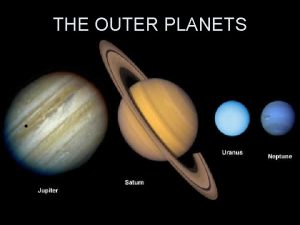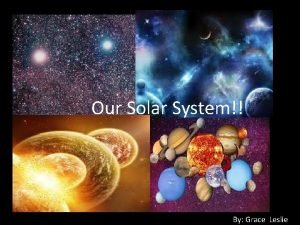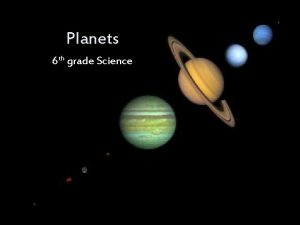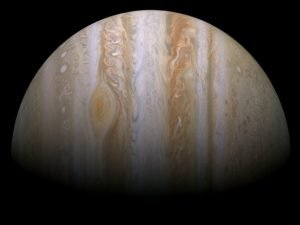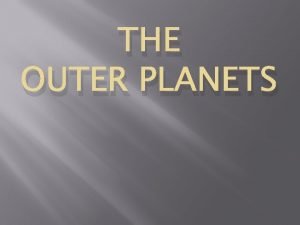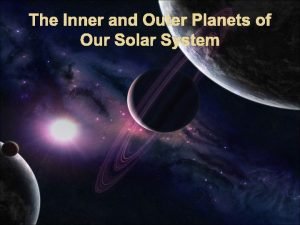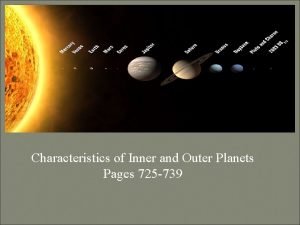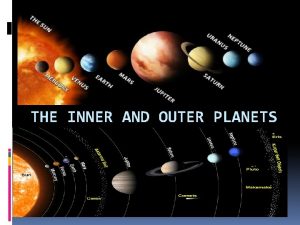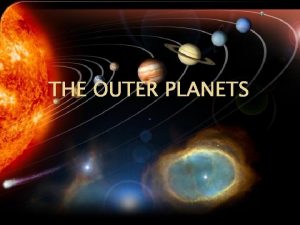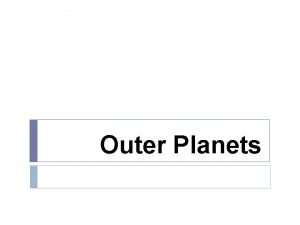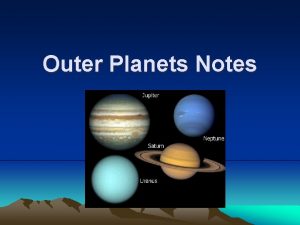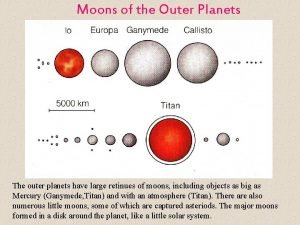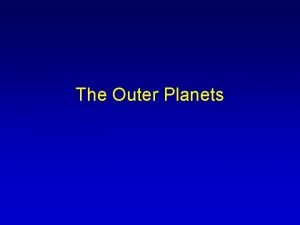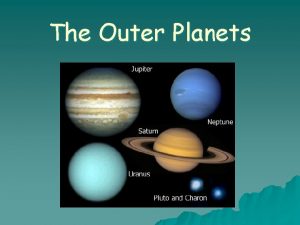Chapter 24 Section 3 Outer Planets Outer Planets










- Slides: 10

Chapter 24 Section 3: Outer Planets

Outer Planets (Jovian) General characteristics: ◦ Low density (mostly gas) ◦ Large size ◦ Many moons

Jupiter Orbital distance: ◦ 778 330 000 km (5. 2 AU) ◦ Not Eccentric Year: ◦ 11. 86 y Day: ◦ 9. 925 h Temperature: ◦ Average at top of clouds 116 K (-157 o. C, -251 o. F) ◦ Extremely hot interior Diameter: ◦ 142 984 km Density: ◦ 1. 326 g/cm 3 Composition: ◦ 90% H, 10% He Axial Tilt: ◦ 3. 1 o Moons: 64 Other: ◦ Great Red Spot ◦ Huge magnetic field ◦ Thin rings

Jupiter’s Moons Io ◦ 4 th largest moon in solar system ◦ Rock, sulfur silicate ◦ Active volcanos Europa ◦ Slightly smaller than Earth’s moon ◦ Watery mantle covered with ice Ganymede ◦ Largest moon in solar system ◦ Rock and water ice Callisto ◦ 3 rd largest moon in solar system ◦ Rock and ice ◦ Thin atmosphere of CO 2


Saturn Orbital distance: ◦ 1 429 400 000 km (9. 54 AU) ◦ Not Eccentric Year: ◦ 29. 46 y Day: ◦ 10. 57 h Temperature: ◦ Average at top of clouds: 84 K (-189 o. C, 308 o. F) ◦ Extremely hot interior Diameter: ◦ 120 536 km Density: ◦ 0. 687 g/cm 3 Composition: ◦ 96% H, 3% He, little NH 3, CH 4 Axial Tilt: ◦ 26. 7 o Moons: 62 Other: ◦ Prominent rings ◦ Weak magnetic field

Titan Only known satellite to have a thick atmosphere 2 nd largest moon in solar system Rock, water ice, liquid hydrocarbons N 2, CH 4 atmosphere Surface T 94 K ( -179 o. C, -290 o. F)

Uranus Orbital distance: ◦ 2 870 990 000 km (19. 2 AU) ◦ Not Eccentric Year: ◦ 84. 3 y Day: ◦ 17. 23 h Temperature: ◦ Top of clouds: 53 K ( -220 o. C, -364 o. F) Diameter: ◦ 51 118 km Density: ◦ 1. 27 g/cm 3 Composition: ◦ Rocky core, ice mantle, H/He atmosphere Axial Tilt: ◦ 97. 77 o Moons: 27 Other: ◦ Thin rings ◦ Magnetic field

Neptune Orbital distance: ◦ 4 504 000 km (30. 06 AU) ◦ Not Eccentric Year: ◦ 164. 79 y Day: ◦ 16. 1 h Temperature: ◦ Top of clouds: 55 K ( -218 o. C, -360 o. F) Diameter: ◦ 49 532 km Density: ◦ 1. 638 g/cm 3 Composition: ◦ Fe/Ni core; mantle of H 2 O, NH 3, CH 4; atmo of H/He Axial Tilt: ◦ 28. 32 o Moons: 13 Other: ◦ Winds of 2000 kph ◦ Thin rings

Triton 7 th largest moon in solar system Retrograde revolution Rocky core, mantle of ice, surface of ice Active geysers of N 2 Captured Kuiper belt object?
 9 planets
9 planets What separates the inner and outer planets?
What separates the inner and outer planets? The inner solar system by leslie
The inner solar system by leslie Inner terrestrial planets
Inner terrestrial planets Why are jovian planets bigger than terrestrial
Why are jovian planets bigger than terrestrial Saturn compared to earth
Saturn compared to earth Length of orbit on saturn
Length of orbit on saturn Jupiter is noticeably oblate because:
Jupiter is noticeably oblate because: Inner outer planets venn diagram
Inner outer planets venn diagram Is mercury an inner or outer planet
Is mercury an inner or outer planet What separates the inner and outer planets
What separates the inner and outer planets
